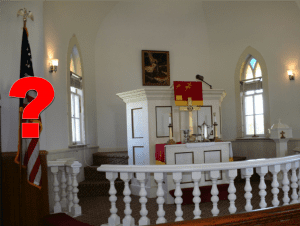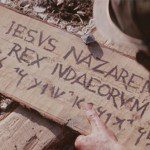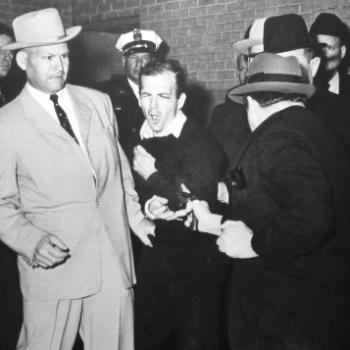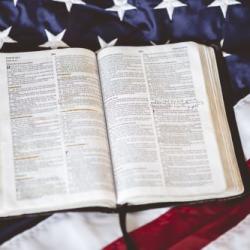The sermon “This Flag Has Legs” invites — and models — dialogue for listening to conflicting ideas and meanings that people attach to the U.S. flag in church.

The sermon, “This Flag Has Legs” is part three in a four-part series on countering Christian Nationalism during patriotic holidays. [See the end of this piece for links to the other sermons in this series.]
This is an excerpt from Chapter 21 of the preaching textbook, Introduction to Preaching: Scripture, Theology, and Sermon Preparation, which I co-wrote with Jerry Sumney and Emily Askew.
This sermon uses Eugene Lowry’s “Homiletical Plot” form. This form takes the classic structure of a plot diagram (exposition, conflict, rising action, climax, falling action, resolution) and applies it to a sermon.
Lowry’s Homiletical Plot form follows the following sequence:
- Conflict (“Uh-oh!”)
- Complication (“Ugh!”)
- Sudden Shift (“A-ha!”)
- Experiencing the Gospel (“Whee”!)
- Anticipating the Consequences (“Yeah!”)
This is not to say that the sermon should necessarily be a story in and of itself (although that is one form that a sermon can take). Rather, the preacher should work with the same principles that draw people into an engaging story from beginning to end. You’ll see that each of the five stages is clearly marked in paragraphs 2, 5, 9, 10, and 11.
Like the previous two sermons in this series, this one is also based on Exodus 20:1-6.
Exodus 20:1-6
Then God spoke all these words:
2I am the Lord your God, who brought you out of the land of Egypt, out of the house of slavery; 3you shall have no other gods before me.
4You shall not make for yourself an idol, whether in the form of anything that is in heaven above, or that is on the earth beneath, or that is in the water under the earth. 5You shall not bow down to them or worship them; for I the Lord your God am a jealous God, punishing children for the iniquity of parents, to the third and the fourth generation of those who reject me, 6but showing steadfast love to the thousandth generation of those who love me and keep my commandments.
Central Purpose
In this example of a sermon for Exodus 20:1-6, I chose this Central Purpose:
This sermon initiates a conversation about what it means to worship the God of Israel so that we can speak honestly about fulfilling the commandment not to worship other gods.
(See this post for the Central Question and Central Claim for this set of sermons.)
“This Flag Has Legs: A Sermon Inviting Dialogue about Flag Placement in Church”
[INTRODUCTION]
- Pastor Tom begins his new call at Church of the Savior fresh out of seminary. He is passionate about addressing social issues and is on fire to prove himself as a social justice advocate for the sake of the gospel. On his first day, he strides into the empty sanctuary and sees the U.S. flag right in the front of the chancel. Pastor Tom knows that having the flag in the sanctuary breaks the first commandment because it is a form of graven imagery and an idol of nationalism. God gave this command so that the Israelites could be liberated from their oppressors and not fall prey to idolatry once they were free. Having the U.S. flag right there in the sanctuary just a few feet from the cross makes his blood boil. So without a second thought, he marches it out of the sanctuary and into a room in the church basement.
[STAGE ONE: CONFLICT/ “UH-OH!”)]
- But a few days later, the flag mysteriously appears right back in the sanctuary where it had been before. Grumbling to himself about idolatry, he moves it again to the basement. And again a few days later, it pops up right back in its usual spot. “Hm,” Pastor Tom thinks to himself. “This flag has legs.”
- He doesn’t know who keeps moving the flag back into the sanctuary, but he suspects it might be the custodian, Albert. So, he confronts Albert about why he keeps moving the flag back into the sanctuary, explaining to him why it is idolatrous for the flag to be there. The custodian shakes his head, “It wasn’t me. But you could ask Gladys, the head of the altar guild. She might know.”
- Gladys is the sweet, unassuming widow who makes sure that the paraments on the altar are clean and correct for every season. She faithfully sets out the communion elements each week. And she sees to it that there is a glass of water on the pulpit for Pastor Tom every Sunday. One day after the service as she is in the sacristy washing out the chalice, he asks if she knows who might be moving the flag back to the sanctuary after he removes it. He mentions that it is idolatrous for the flag to be there because it breaks the first commandment.
[STAGE TWO: COMPLICATION/ “UGH”]
- Sweet Gladys erupts in tears and anger. “So, you’re the one who keeps moving the flag! I wondered why all of a sudden this flag has legs!” She tells him about her husband who died in the war defending this country. When she sees that flag, it reminds her that her husband is still with her in spirit every Sunday at church. “You have no appreciation for the sacrifice he made for you,” she spits before whirling around and walking out of the sacristy.
- Realizing that he had mishandled the situation, Pastor Tom sends a heartfelt note of apology to Gladys and asks if he can take her out for coffee so that they can clear the air. “I want to hear more about your husband,” he writes. Generously, she invites him to her home where she shows him pictures of Stewart, her beloved. There he is with sparkling eyes in his grade school picture. Here they are on their wedding day. In this one he is posing proudly in his military uniform. Over fresh-squeezed lemonade, Gladys tells Pastor Tom about her husband and why his sacrifice for the country means so much to her.
- “But enough about me,” Gladys says. “Tell me about how you decided to become a pastor.” He tells her about his grandparents who brought him to church as a boy and encouraged him as he joined the youth group and went on mission trips. He explained that his grandfather had fought the Nazis in Germany. “He told me about how the Nazis put that hateful swastika flag in churches. ‘No flag belongs in a church,’ he told me. ‘The church is God’s house, no matter what country it might be in.’ I’ve always remembered that. And when I went to seminary and learned about why it’s so important to honor the First Commandment, I promised myself that I would never allow a flag in a church, no matter where I served. That’s why I moved the flag out, Gladys. Not to dishonor your husband, but to honor God.”
- Gladys listened thoughtfully and nodded her head. “It seems we’ve reached an impasse. I’m not willing to see the flag removed. You’re not willing to see the flag stay. What do we do?”
[STAGE THREE: SUDDEN SHIFT/ “A-HA”]

- The pastor thought for a moment, then said, “I’m sure we’re not the only ones to have conflicted feelings about this. I wonder if we could have a larger conversation about this with others in the church? Maybe together we can have a dialogue to help us find a way through. Maybe God is using this to invite us into a conversation.”
[STAGE FOUR: EXPERIENCING THE GOSPEL/“WHEE!”]
- So, the two of them, Pastor Tom and Gladys, talked with the church council about their dilemma. Together, they came up with the idea to hold a series of forums for people to share what the flag means to them – the good, the bad, and the ugly – as well as what the First Commandment means to them. With Bible studies, personal stories, and deep, honest sharing and listening, the congregation spent several weeks discerning God’s will for them regarding this issue. In the end, they agreed to move the flag to the back of the sanctuary so that it was not in the chancel but could still be visible for those who wanted to see it. And rather than bringing the flag front and center near the holidays of Memorial Day and Fourth of July (which had been their custom), they added a special remembrance on All Saints Day for those who died in service of their country. The compromise was not what Pastor Tom or Gladys had originally wanted. It wasn’t a perfect solution for either of them. But they — and the congregation — moved one step closer to a deeper relationship with God and each other.
[STAGE FIVE: UNFOLDING/ “YEAH!”]
- What does it mean to worship the God of Israel who commands us not to have graven images? In what ways can we listen to the different ideas and meanings each of us attaches to the flag? How will the church witness to the God of liberation in this church, and in this community? I don’t know the answers, but I’m really interested in these questions. I know each of us takes seriously the First Commandment. And I also know there are very strong feelings about having the flag in the sanctuary – both for and against. As with Pastor Tom and Gladys, I believe God is inviting our congregation to a conversation, and I hope you will join us for this. [Invitation to the date and time of the discussion.]
- This flag has legs, yes. But so does the cross. Both the flag and the cross can move front and center – and they can step aside. They can kneel and they can stand. They can walk towards each other, and they can walk away. God can do powerful things with just one step forward. Let’s take that step together.

Reflecting on the strategy of this sermon
“This Flag Has Legs” modeled the kind of conversation the preacher would hope to have within the congregation. Notice, that the pastor in this story was not the “hero.” He made some blunders. But guided by compassion and with the grace of forgiveness, Pastor Tom and Gladys were able to try again to listen and learn from each other.
They took their dilemma to the church’s governing body in the spirit of dialogue which resulted in an outcome that moved beyond the dichotomous thinking that created the conflict in the first place.
The sermon concludes by recapitulating Pastor Tom’s words, “This flag has legs,” which had been a moment of ironic drama when Gladys said the same thing. At the sermon’s end, this image of the flag having legs is juxtaposed with the cross also having legs. And the metaphor frames the invitation to dialogue by inviting them to step forward together. In this way, the sermon comes to its resolution while also leaving open possibilities for future engagement.
Stay tuned for part four in this series!
More information about countering Christian Nationalism
Faithful America has put together a very helpful collection of preaching resources and sample prayers as part of a toolkit to equip clergy and congregations to counter the toxic effects of Christian Nationalism and to bear witness for peace and love. These resources work well in the lead up to Flag Day, as well as for the week of Independence Day. To access the toolkit, click here.
Read the other sermons in this series exploring flag placement in the church through preaching:
U.S. Flag in the Church? Preaching on Patriotic Holidays
Flagging the Flag – Idolatry and Freedom: Preaching Exodus 20:1-6
The Big Red, White, and Blue in the Room: A Sermon about Deliberating the Flag in Church
Read also:
Flag Placement in Church: How to Have the Conversation

The Rev. Dr. Leah D. Schade is the Associate Professor of Preaching and Worship at Lexington Theological Seminary in Kentucky and ordained in the ELCA. Dr. Schade does not speak for LTS or the ELCA; her opinions are her own. She is the author of Preaching in the Purple Zone: Ministry in the Red-Blue Divide (Rowman & Littlefield, 2019) and Creation-Crisis Preaching: Ecology, Theology, and the Pulpit (Chalice Press, 2015). She is the co-editor of Rooted and Rising: Voices of Courage in a Time of Climate Crisis (Rowman & Littlefield, 2019). Her newest book is Introduction to Preaching: Scripture, Theology, and Sermon Preparation, co-authored with Jerry L. Sumney and Emily Askew (Rowman & Littlefield, 2023).

















